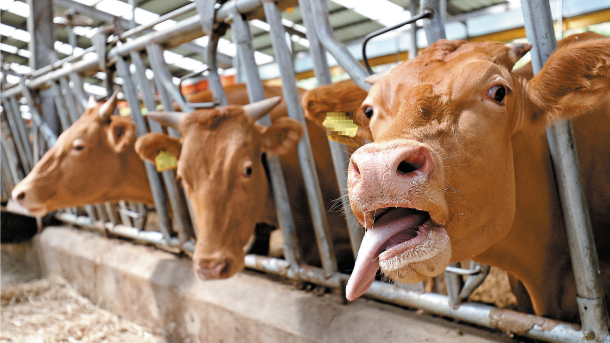Heat wave kills 6, sickens 547

A cow sticks its tongue out to lower its body temperature in a pen in Gangneung, Gangwon, on Tuesday as a scorching heat wave sweeps the country. Many farmers spray water to cool off the cows and their pens. [NEWS1]
From May 20 to Sunday, 551 people suffered problems due to lengthened exposure to the sun, including headaches, dizziness, muscle spasms and sunstrokes, of whom four died, the Korea Centers for Disease Control and Prevention (KCDC) said Tuesday in a statement. Of the 551 cases, 285, or 52 percent, took place from Thursday to Sunday.
The number was higher than last year, when 466 people got sick from the heat from May 29 to July 19, of whom three died. The year before that, 539 people got sick from the heat from May 23 to July 24, of whom five died, according to the KCDC.
From 2011 to 2017, some 55 people have died from heat-related illnesses, according to the center. More than half were people over the age of 70.
According to the KCDC, four people died from heat stroke in recent weeks including a 78-year-old woman in Gangneung, Gangwon, who was found unconscious near her house on June 23; a 2-year-old boy in Uiryeong County, South Gyeongsang, who was found unconscious in a car on July 4; an 86-year-old woman who was found unconscious in a farmer’s field in Gimhae, South Gyeongsang, on Thursday; and an 84-year-old woman who was found unconscious near her house in Changwon, South Gyeongsang, on Sunday.
On Tuesday, the North Jeolla provincial government announced that a man in his 80s was found unconscious Monday in Namwon, North Jeolla. He was moved to a hospital but died of heat stroke, the hospital said. On Tuesday, a 4-year-old girl was found dead in a day care center bus in Dongducheon, Gyeonggi. Authorities suspect she was left on board from 9:30 a.m. to 4:30 p.m. and died of heat stroke.
The Korea Meteorological Administration issued heat wave advisories and warnings throughout the country on Tuesday. A heat wave advisory is issued when the highest temperature is expected to be above 33 degrees Celsius (91.4 degrees Fahrenheit) for two days or more. A heat wave warning is issued when the highest temperature during the day is expected to be higher than 35 degrees Celsius for over two days.
Heat wave advisories and warnings were issued in the South Gyeongsang region nine times from June 22 to Tuesday, according to the Korea Meteorological Administration. They were issued five times in the same period in the Seoul, Gyeonggi and Incheon regions.
For natural disasters, including heat wave warnings, the Ministry of the Interior sends out warning messages with loud siren sounds via cell phones. It does not send out a warning text message for heat wave advisories. Among the five heat wave advisories and warnings issued in Seoul from June 22 to Tuesday, only one was a heat wave warning, which was on Monday.
Out of the 551 cases of people having heat-related health problems, the greatest number - 97 - occurred in South Gyeongsang. There were 65 in Gyeonggi, 64 in North Gyeongsang, 50 in South Jeolla, 40 in Gangwon and 33 in Seoul.
“In the past five years, there have been 6,500 cases of heat-related illnesses reported to the center, and 40 percent of these cases took place between 12 p.m. and 5 p.m. at an outdoor space, usually a farmer’s field,” the KCDC said. “We request people that avoid outdoor activities during the afternoon when heat wave warnings are issued.”
The Ministry of Agriculture, Food and Rural Affairs said about 50 out of the 551 people who suffered heat-related illnesses were farmers.
In a press briefing Tuesday at its headquarters in Sejong, the ministry announced that as many as 790,000 livestock in Korea have died as of Tuesday due to the heat of the last couple of weeks. This was nearly 30 percent more than during the same period last year when around 600,000 animals died.
In detail, some 3,500 pigs and 750,000 chickens have died in the heat.
The Agriculture Ministry estimates that this has caused as much as 4.2 billion won ($3.7 million) in financial damages to farmers.
“The rainy season came to an end much earlier than expected, so the heat wave arrived earlier than usual,” said Lee Ju-myeung, director general at the agricultural policy bureau of the ministry.
“The heat wave will stay until early August,” he said, “so we believe the damage caused by the weather to farmers will increase.”
The number of animal deaths during summers has been on the rise in recent years, from 1.12 million in 2014 to 2.67 million in 2015. The number jumped to 6.29 million in 2016 and 7.26 million last year.
“The hike in the number of animal deaths in 2016 was largely due to the fact that we had heat waves at the same time as a severe draught,” Lee said.
BY ESTHER CHUNG, CHOI HYUNG-JO [chung.juhee@joongang.co.kr]










with the Korea JoongAng Daily
To write comments, please log in to one of the accounts.
Standards Board Policy (0/250자)